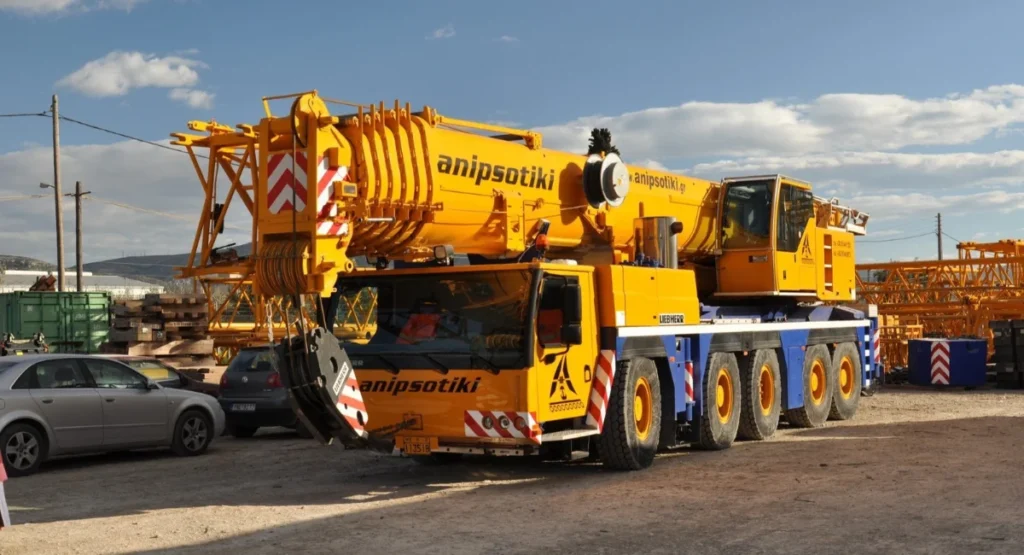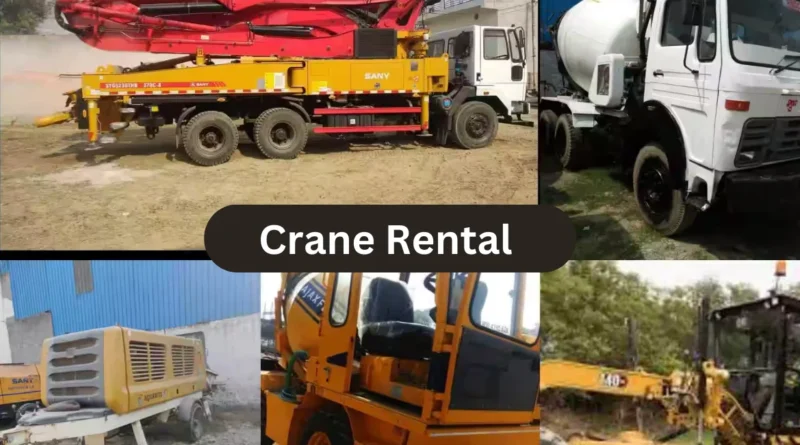Crane Rental Prices Per Day and 6 Factors Affect Rental Cost Blog.sentigum.com
When it comes to heavy lifting, cranes are the unsung heroes of the construction and industrial worlds. Whether you’re hoisting steel beams or repositioning machinery, understanding crane rental prices per day is essential for budgeting your project effectively. But what exactly influences those rental costs?
From the type and size of the crane to additional services you might need, several factors can impact how much you’ll pay. If you’ve ever wondered why some rentals seem more expensive than others, you’re not alone. Join us as we explore these key elements that determine crane rental prices and provide tips on getting the best deal possible. Your next big project could depend on it!

Understanding Crane Rental Prices
Understanding crane rental prices is crucial for any construction or project manager. These costs can vary widely, making it essential to grasp the underlying factors.
Crane rentals are typically charged on a daily or weekly basis, but other elements come into play. Rental companies often base their pricing models on equipment size, type, and capacity.
Additionally, the complexity of your project can influence rates significantly. More specialized cranes may demand higher fees due to their unique features and capabilities.
Seasonal demand also contributes to fluctuating prices; during peak times, you might see rates soar as companies rush to secure available machinery. By familiarizing yourself with these aspects of crane rental pricing, you’ll be better equipped to make informed decisions that align with your budget and timeline.
Crane Rental Prices Per Day
Crane rental prices per day can vary significantly based on multiple factors. Generally, you might expect to pay anywhere from $200 to over $1,500 daily. The precise cost hinges on the crane type and its capacity.
For example, smaller cranes designed for light lifting tasks often fall at the lower end of this spectrum. In contrast, heavy-duty models used for major construction projects can reach premium rates.
Rental duration also plays a role in pricing. Longer rentals may qualify for discounts, while short-term needs could lead to higher daily charges.
It’s essential to clarify what’s included in your rental agreement. Some companies offer bundled services that cover transport and setup, which can influence overall costs substantially as well.
Understanding these variables will help you budget more effectively when considering crane rental options for your project.

Crane rental prices per day and 6 factors affect rental cost blog.sentigum.com
When considering crane rental costs blog.sentigum.com several factors come into play. First and foremost is the type of crane required for your project. Different cranes serve various purposes, from boom trucks to tower cranes, each affecting daily rates.
The size and capacity of the crane also matter significantly. Larger cranes designed for heavier loads tend to cost more than smaller models due to their advanced engineering and capabilities.
Additional services can impact your overall expense too. Services such as delivery, setup, or operator training may incur extra fees.
Demand and availability in your location are crucial elements that influence rental prices. High demand during peak seasons can drive up costs while limited supply might result in higher quotes.
Each of these factors plays a vital role in determining the final price you’ll pay for renting a crane tailored to meet your specific needs.
1. Type of Crane
The type of crane plays a crucial role in determining rental prices. Different cranes are designed for specific tasks, making some more expensive than others.
For instance, a tower crane, used in high-rise construction, generally comes with a higher price tag due to its specialized capabilities. On the other hand, a smaller boom lift may be more affordable for short-term projects.
Each crane’s unique features and functionalities contribute to pricing structures. As you consider your project needs, it’s essential to understand which type will best serve your requirements without breaking the budget.
Additionally, certain types have increased demand depending on industry trends or seasonal projects. This can also affect costs associated with renting them. Therefore, selecting the right crane is not just about capability but also about aligning with your financial plan.
2. Size and Capacity of crane
The size and capacity of a crane play pivotal roles in determining rental costs. Larger cranes typically command higher prices due to their enhanced lifting capabilities and specialized equipment.
When choosing a crane, consider the weight of the materials you need to lift. A heavier load requires a more robust machine, which can increase the daily rental rate significantly.
Space constraints on your job site also affect your selection. If you’re working in tight areas, you may need a smaller crane that is easier to maneuver but offers less lifting power.
Conversely, if you have ample space and require heavy lifts regularly, investing in larger cranes could be more cost-effective despite their higher initial rental price. Always assess both your immediate needs and future projects when evaluating options within this category.
3. Additional Services
When renting a crane, additional services can significantly impact your overall cost. These might include operator training, transportation fees, and site preparation assistance. Each of these factors adds to the daily rental price.
Having a trained operator is crucial for safe operation. This service often comes at an extra charge but ensures that the project runs smoothly without safety risks.
Transportation costs are another aspect to consider. If the crane needs to be moved over long distances, it can add significant expenses to your budget.
Additionally, some companies offer maintenance support during your rental period. This service helps ensure optimal performance and minimizes downtime on-site.
Understanding these added services allows you to better gauge the true cost of renting a crane and plan accordingly for your budget.
4. Demand and Availability
Demand and availability are crucial elements in determining crane rental prices per day. When construction projects surge, the need for cranes often skyrockets. This increased demand can lead to higher rental rates.
Conversely, during quieter months or off-peak seasons, rates may drop as companies compete for business. Rental agencies might offer discounts or special packages to attract clients when inventory is plentiful.
Location also plays a significant role. Urban areas typically experience greater demand than rural locations, impacting pricing strategies.
Additionally, unforeseen events like natural disasters can suddenly elevate the need for heavy equipment. This unpredictability makes it essential for businesses to plan ahead and secure rentals early to avoid inflated costs later on.
Understanding these dynamics helps contractors budget effectively while ensuring they have access to the right equipment at competitive prices.
5. Location
Location plays a crucial role in determining crane rental prices per day. Prices can vary significantly depending on where you are situated. Urban areas often see higher rates due to increased demand and logistical challenges.
In contrast, rural locations may present lower costs but could face limitations regarding availability. If you’re renting from a supplier far away, transportation fees can add up quickly, impacting the overall price.
Local regulations also influence costs. Some regions require permits or inspections before using heavy equipment like cranes. These additional requirements can lead to extra charges.
Another factor is the competition among rental companies in your area. A saturated market might drive prices down, while limited options could inflate them considerably. Understanding these location-specific dynamics is essential for budgeting accurately when planning your project.
Also Read: Amazon Project kuiperalamalhodaitechcrunch | Gmail.com Zaloguj | Showbizztoday.com
Tips for Negotiating Crane Rental Prices
When negotiating crane rental prices, preparation is key. Research local market rates to understand what’s reasonable for your area. This knowledge gives you a solid foundation when discussing costs.
Don’t hesitate to ask about discounts or promotions. Many companies offer deals that can significantly reduce expenses, especially for extended rentals.
Be clear about your project timeline and needs. If the rental company knows you require the crane for an extended period or have specific requirements, they may be willing to provide a better rate.
Maintain open communication throughout the negotiation process. Building rapport with the rental provider can lead to more favorable terms.
Consider bundling services as well. Renting additional equipment from the same company might yield lower overall costs while ensuring all aspects of your project are managed seamlessly.
The Importance of Properly Maintained Cranes
Proper maintenance of cranes is crucial for safe operations. A well-maintained crane minimizes the risk of accidents on site. Regular inspections and servicing ensure that all components function optimally.
Neglecting maintenance can lead to mechanical failures during critical lifts. This not only jeopardizes the safety of workers but also results in costly downtime. Equipment that’s out of service affects project timelines and budgets.
Additionally, properly maintained cranes have a longer lifespan. Investing in regular upkeep reduces replacement costs over time. It’s an essential strategy for businesses looking to maximize their equipment’s value.
Moreover, compliance with safety regulations is paramount in the construction industry. Well-kept cranes are less likely to encounter issues that could violate these standards, protecting your company from legal repercussions. Prioritizing crane maintenance fosters a culture of safety and reliability on job sites.
Also Read: Cute:mex-57bk3-e= wallpaper stitch | SEO Melbourne AppKod | Seo Agency in Australia Appkod
Alternatives to Traditional Crane Rentals: Renting vs. Buying
When considering crane options, the choice between renting and buying can be pivotal. Renting offers flexibility. It’s ideal for companies that have fluctuating project needs or limited budgets.
On the other hand, purchasing a crane could be a smarter investment in the long run for businesses with steady demand. Owning equipment means no rental fees, allowing you to allocate funds elsewhere.
However, maintenance costs come into play when owning cranes. They require regular upkeep and inspections to ensure safety and efficiency.
Renting alleviates this burden; you pay only for what you need without worrying about repairs or storage.
Evaluate your project timelines carefully before making a decision. Each option has its advantages depending on your specific business model and financial strategy.
Conclusion
Navigating crane rental prices can feel overwhelming. Understanding the intricacies behind daily rates is essential for effective budgeting.
Evaluating factors like crane type, size, and additional services helps you make informed decisions. Location also plays a significant role in determining costs.
Proper maintenance of cranes not only affects safety but can also influence rental expenses. Renting versus buying presents its own set of challenges that need careful consideration.
By arming yourself with knowledge about these elements, you’re better equipped to negotiate favorable terms. This empowers you to find the best value for your project needs without compromising quality or efficiency.
Stay proactive in researching options and be open to exploring alternatives as they arise. Your investment will ultimately yield smoother operations on-site and lead to successful project outcomes.
FAQs
1. What is the average cost of renting a crane per day?
A. The average cost of renting a crane per day ranges from $200 to $1,000, depending on the crane type and location.
2. How does the type of crane influence rental costs?
A. Different cranes, like mobile or tower cranes, have varying capabilities and rental costs. Larger, more specialized cranes typically cost more.
3. Why does rental duration impact pricing?
A. Longer rental periods often result in discounted daily rates, while shorter rentals might incur higher per-day costs due to logistics and setup.
4. What role does availability play in pricing?
A. High demand or limited availability can drive up prices, especially during peak construction seasons or in densely populated areas.
5. Can insurance affect crane rental costs?
A. Yes, rental companies often require insurance coverage for potential damages, impacting the total rental expense.



